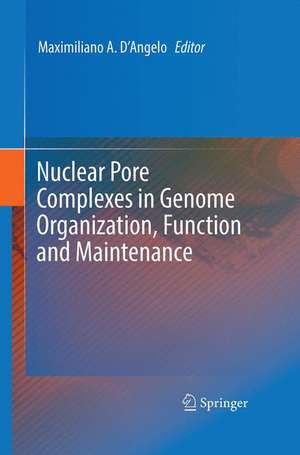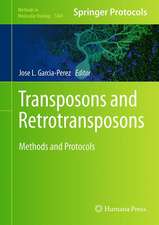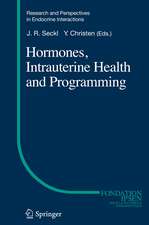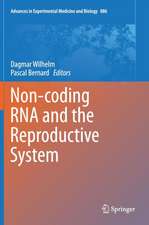Nuclear Pore Complexes in Genome Organization, Function and Maintenance
Editat de Maximiliano D’Angeloen Limba Engleză Hardback – 11 feb 2018
The three-dimensional organization of the DNA inside the eukaryotic cell nucleus has emerged a critical regulator of genome integrity and function. Increasing evidence indicates that nuclear pore complexes (NPCs), the large protein channels that connect the nucleus to the cytoplasm, play a critical role in the establishment and maintenance of chromatin organization and in the regulation of gene activity. These findings, which oppose the traditional view of NPCs as channels with only one: the facilitation of nucleocytoplasmic molecule exchange, have completely transformed our understanding of these structures. This book describes our current knowledge of the role of NPCs in genome organization and gene expression regulation. It starts by providing an overview of the different compartments and structures of the nucleus and how they contribute to organizing the genome, then moves to examine the direct roles of NPCs and their components in gene expression regulation in different organisms, and ends by describing the function of nuclear pores in the infection and genome integration of HIV, in DNA repair and telomere maintenance, and in the regulation of chromosome segregation and mitosis. This book provides an intellectual backdrop for anyone interested in understanding how the gatekeepers of the nucleus contribute to safeguarding the integrity and function of the eukaryotic genome.
| Toate formatele și edițiile | Preț | Express |
|---|---|---|
| Paperback (1) | 1091.71 lei 6-8 săpt. | |
| Springer International Publishing – 5 iun 2019 | 1091.71 lei 6-8 săpt. | |
| Hardback (1) | 1098.63 lei 6-8 săpt. | |
| Springer International Publishing – 11 feb 2018 | 1098.63 lei 6-8 săpt. |
Preț: 1098.63 lei
Preț vechi: 1156.45 lei
-5% Nou
Puncte Express: 1648
Preț estimativ în valută:
210.21€ • 219.50$ • 173.59£
210.21€ • 219.50$ • 173.59£
Carte tipărită la comandă
Livrare economică 15-29 aprilie
Preluare comenzi: 021 569.72.76
Specificații
ISBN-13: 9783319716121
ISBN-10: 3319716123
Pagini: 250
Ilustrații: VIII, 240 p. 32 illus. in color.
Dimensiuni: 155 x 235 mm
Greutate: 0.53 kg
Ediția:1st ed. 2018
Editura: Springer International Publishing
Colecția Springer
Locul publicării:Cham, Switzerland
ISBN-10: 3319716123
Pagini: 250
Ilustrații: VIII, 240 p. 32 illus. in color.
Dimensiuni: 155 x 235 mm
Greutate: 0.53 kg
Ediția:1st ed. 2018
Editura: Springer International Publishing
Colecția Springer
Locul publicării:Cham, Switzerland
Cuprins
Nuclear Pore Complexes In The Regulation Of Genome Organization And Gene Expression
Contents:
1. Spatial Organization Of The Nucleus Compartmentalizes And Regulates The Genome
Michael I. Robson, Andrea Rizzotto, and Eric C. Schirmer
1.1 Introduction
1.2 Subdomains of the nucleus
1.2.1 Nuclear Envelope 1.2.2 Nuclear pore complexes
1.2.3 Chromosomes
1.2.4 Centromeres 1.2.5 Telomeres
1.2.6 Nucleolus
1.2.7 Perinucleolar compartment 1.2.8 Cajal bodies
1.2.9 Gemini of coiled bodies
1.2.10 PML/ND10 bodies 1.2.11 Speckles
1.2.12 Paraspeckles
1.2.13 Histone bodies 1.2.14 Polycomb bodies
1.3 Composition of nuclear structures
1.4 Self-assembly of nuclear structures 1.5 Genome organization patterns
1.5.1 Loops and topologically-associated domains
1.5.2 Compartments
1.6 Structure-function relationships
1.6.1 Layers of functional separation
1.6.2 Loops
1.6.3 Scaffolds
1.6.4 Boundary elements
1.7 General versus tissue- or state-specific functions
1.8 Conclusions and open questions
1.9 References
2. The Molecular Composition And Function Of The Nuclear Periphery And Its Impact On The Genome
C. Patrick Lusk and Megan C. King
2.1 The conservation of the spatial positioning of the genome across eukaryotes
2.2 Integral INM proteins
2.3 A brief history of INM targeting
2.4 The nuclear lamina
2.5 Lamina Associated Domains
2.6 LADs as developmentally regulated regions
2.7 Histone modifications at the nuclear periphery
2.8 Peripheral tethers
2.9 Lamina Associated Sequences
2.10 Beyond silencing: the periphery and genome integrity
2.11 Repetitive DNA and the nuclear periphery
2.12 Inputs of nuclear compartmentalization on DNA repair mechanisms
2.13 Outlook
2.14 References
3. Nuclear Pore Complexes: Fascinating Nucleocytoplasmic Checkpoints
Victor Shahin
3.1 Introduction
3.2 Versatility of the NPCs structural configuration
3.3 Composition, heterogeneity and dynamics of the NPCs
3.4 NPCs as fascinating gatekeepers between the cytoplasm and the nucleus
3.5 Configuration and functional mechanisms of the selective NPC barrier: FG-Nups
3.6 References
4. Nuclear Pore Complex In Genome Organization And Gene Expression In Yeast
Carlo Randise-Hinchliff and Jason H Brickner
4.1 Introduction
4.2 Spatial organization of the yeast genome
4.3 Composition of NPC 4.4 Nuclear pore complex interacts with the genome
4.5 Nups influence transcription
4.6 Mechanisms of Gene recruitment 4.7 Interchromosomal clustering at the NPC
4.8 Regulation of gene recruitment and clustering
4.9 Gene recruitment and clustering through the cell cycle
4.10 Transcription Memory
4.11 Molecular mechanism of INO1 transcriptional memory
4.12 Concluding Remarks
4.13 References
5. Nuclear Pore Complex In Genome Organization And Gene Expression In Drosophila
Terra Kuhn and Maya Capelson
5.1 Introduction
5.2 Unique features of Drosophila NPC structure and assembly
5.3 Phenotypes of Drosophila Nups
5.3.1 Components of the Nup107-160 sub-complex in Drosophila speciation
5.3.2 NPC components and ALS/FTD pathogenesis
5.3.3 Cytoplasmic Nups in immune response and import of NF-κB
5.3.4 Roles of Drosophila Nups in germ cell development
5.4 Chromatin-binding roles of Drosophila Nups in gene regulation
5.4.1 Nups interact with chromatin on and off the NPC
5.4.2 Drosophila Nups and Dosage Compensation machinery
5.4.3 Physiological gene targets of Drosophila Nups
5.4.4 Roles of Drosophila Nups in non-transcribing chromatin
5.4.5 Possible mechanisms of gene regulatory roles of Nups
5.5 Concluding Remarks
5.6 References
6. Caenorhabditis elegans Nuclear Pore Complexes In Genome Organization And Gene Expression
Celia María Muñoz-Jiménez and Peter Askjaer
6.1 Introduction 6.2 C. elegans NPC composition
6.3 Association of nups with chromatin
6.4 Gene repositioning upon transcriptional activation 6.5 The NPC in nucleocytoplasmic transport and beyond
6.6 The NPC during aging
6.7 Concluding Remarks 6.8 References
7. Mammalian Nuclear Pore Complexes In Genome Organization And Gene Expression
Marcela Raices and Maximiliano A D’Angelo
7.1 Introduction 7.2 Stability, mobility and lifespan of mammalian NPCs
7.3 Chromatin interactions with mammalian NPCs
7.4 Gene expression regulation at NPCs
7.4.1 Genes that associate with mammalian NPCs
7.4.2 Mechanisms of gene-expression regulation by NPCs
7.5 Gene expression regulation by nucleoporins in the nuclear interior
7.5.1 Genes that associate with intranuclear nucleoporins
7.5.2 Mechanisms of gene-expression regulation by intranuclear nucleoporins
7.6 Gene regulation by abnormal nucleoporin fusion proteins
7.7 Concluding Remarks
7.8 References
8. Nuclear Pore Complexes, Genome Organization And HIV-1 Infection
Francesca Di Nunzio
8.1 Introduction
8.2 Early steps of HIV-1 infection
8.3 Role of NPC Components in HIV-1 Replication
8.3.1 Nups and HIV-1 Uncoating
8.3.2 Nups and HIV-1 Translocation
8.3.3 Nups and HIV-1 Integration
8.4 Concluding Remarks
8.5 References
9. Nuclear Pore Complexes In DNA Repair And Telomere Maintenance
Marie-Noelle Simon, Alkmini Kalousi, Evi Soutoglou, Vincent Géli and Catherine Dargemont
9.1 The Nuclear Pore Complex: overall organization and architectural plasticity
9.2 NPC and DNA repair in yeast
9.2.1 Role of Nucleoporins
9.2.2 NPC regulates HR at specific types of DNA lesions
9.3 NPC and DNA repair in mammals
9.4 NPC regulates telomere recombination during pre-senescence and survivor formation
9.5 Concluding Remarks
9.6 References
10. NPCs in mitosis and chromosome segregation Masaharu Hazawa, Akiko Kobayashi and Richard W. Wong
10.1 NPC structure and composition
10.2 Function of NPC components in chromosome segregation and mitotic apparatus orchestration during mitosis
10.2.1 Nup358/RanBP2 subcomplex in mitosis
10.2.2 Nup62 subcomplex in mitosis
10.2.3 Nup107–Nup160 subcomplex in mitosis 10.2.4 Tpr–Nup153 subcomplex in mitosis
10.2.5 Rae1–Nup98 subcomplex in mitosis
10.3 Viral Nups in mitosis 10.4 ESCRT-III in NE/NPC sealing at the end of mitosis
10.5 Concluding Remarks
10.6 References
Contents:
1. Spatial Organization Of The Nucleus Compartmentalizes And Regulates The Genome
Michael I. Robson, Andrea Rizzotto, and Eric C. Schirmer
1.1 Introduction
1.2 Subdomains of the nucleus
1.2.1 Nuclear Envelope 1.2.2 Nuclear pore complexes
1.2.3 Chromosomes
1.2.4 Centromeres 1.2.5 Telomeres
1.2.6 Nucleolus
1.2.7 Perinucleolar compartment 1.2.8 Cajal bodies
1.2.9 Gemini of coiled bodies
1.2.10 PML/ND10 bodies 1.2.11 Speckles
1.2.12 Paraspeckles
1.2.13 Histone bodies 1.2.14 Polycomb bodies
1.3 Composition of nuclear structures
1.4 Self-assembly of nuclear structures 1.5 Genome organization patterns
1.5.1 Loops and topologically-associated domains
1.5.2 Compartments
1.6 Structure-function relationships
1.6.1 Layers of functional separation
1.6.2 Loops
1.6.3 Scaffolds
1.6.4 Boundary elements
1.7 General versus tissue- or state-specific functions
1.8 Conclusions and open questions
1.9 References
2. The Molecular Composition And Function Of The Nuclear Periphery And Its Impact On The Genome
C. Patrick Lusk and Megan C. King
2.1 The conservation of the spatial positioning of the genome across eukaryotes
2.2 Integral INM proteins
2.3 A brief history of INM targeting
2.4 The nuclear lamina
2.5 Lamina Associated Domains
2.6 LADs as developmentally regulated regions
2.7 Histone modifications at the nuclear periphery
2.8 Peripheral tethers
2.9 Lamina Associated Sequences
2.10 Beyond silencing: the periphery and genome integrity
2.11 Repetitive DNA and the nuclear periphery
2.12 Inputs of nuclear compartmentalization on DNA repair mechanisms
2.13 Outlook
2.14 References
3. Nuclear Pore Complexes: Fascinating Nucleocytoplasmic Checkpoints
Victor Shahin
3.1 Introduction
3.2 Versatility of the NPCs structural configuration
3.3 Composition, heterogeneity and dynamics of the NPCs
3.4 NPCs as fascinating gatekeepers between the cytoplasm and the nucleus
3.5 Configuration and functional mechanisms of the selective NPC barrier: FG-Nups
3.6 References
4. Nuclear Pore Complex In Genome Organization And Gene Expression In Yeast
Carlo Randise-Hinchliff and Jason H Brickner
4.1 Introduction
4.2 Spatial organization of the yeast genome
4.3 Composition of NPC 4.4 Nuclear pore complex interacts with the genome
4.5 Nups influence transcription
4.6 Mechanisms of Gene recruitment 4.7 Interchromosomal clustering at the NPC
4.8 Regulation of gene recruitment and clustering
4.9 Gene recruitment and clustering through the cell cycle
4.10 Transcription Memory
4.11 Molecular mechanism of INO1 transcriptional memory
4.12 Concluding Remarks
4.13 References
5. Nuclear Pore Complex In Genome Organization And Gene Expression In Drosophila
Terra Kuhn and Maya Capelson
5.1 Introduction
5.2 Unique features of Drosophila NPC structure and assembly
5.3 Phenotypes of Drosophila Nups
5.3.1 Components of the Nup107-160 sub-complex in Drosophila speciation
5.3.2 NPC components and ALS/FTD pathogenesis
5.3.3 Cytoplasmic Nups in immune response and import of NF-κB
5.3.4 Roles of Drosophila Nups in germ cell development
5.4 Chromatin-binding roles of Drosophila Nups in gene regulation
5.4.1 Nups interact with chromatin on and off the NPC
5.4.2 Drosophila Nups and Dosage Compensation machinery
5.4.3 Physiological gene targets of Drosophila Nups
5.4.4 Roles of Drosophila Nups in non-transcribing chromatin
5.4.5 Possible mechanisms of gene regulatory roles of Nups
5.5 Concluding Remarks
5.6 References
6. Caenorhabditis elegans Nuclear Pore Complexes In Genome Organization And Gene Expression
Celia María Muñoz-Jiménez and Peter Askjaer
6.1 Introduction 6.2 C. elegans NPC composition
6.3 Association of nups with chromatin
6.4 Gene repositioning upon transcriptional activation 6.5 The NPC in nucleocytoplasmic transport and beyond
6.6 The NPC during aging
6.7 Concluding Remarks 6.8 References
7. Mammalian Nuclear Pore Complexes In Genome Organization And Gene Expression
Marcela Raices and Maximiliano A D’Angelo
7.1 Introduction 7.2 Stability, mobility and lifespan of mammalian NPCs
7.3 Chromatin interactions with mammalian NPCs
7.4 Gene expression regulation at NPCs
7.4.1 Genes that associate with mammalian NPCs
7.4.2 Mechanisms of gene-expression regulation by NPCs
7.5 Gene expression regulation by nucleoporins in the nuclear interior
7.5.1 Genes that associate with intranuclear nucleoporins
7.5.2 Mechanisms of gene-expression regulation by intranuclear nucleoporins
7.6 Gene regulation by abnormal nucleoporin fusion proteins
7.7 Concluding Remarks
7.8 References
8. Nuclear Pore Complexes, Genome Organization And HIV-1 Infection
Francesca Di Nunzio
8.1 Introduction
8.2 Early steps of HIV-1 infection
8.3 Role of NPC Components in HIV-1 Replication
8.3.1 Nups and HIV-1 Uncoating
8.3.2 Nups and HIV-1 Translocation
8.3.3 Nups and HIV-1 Integration
8.4 Concluding Remarks
8.5 References
9. Nuclear Pore Complexes In DNA Repair And Telomere Maintenance
Marie-Noelle Simon, Alkmini Kalousi, Evi Soutoglou, Vincent Géli and Catherine Dargemont
9.1 The Nuclear Pore Complex: overall organization and architectural plasticity
9.2 NPC and DNA repair in yeast
9.2.1 Role of Nucleoporins
9.2.2 NPC regulates HR at specific types of DNA lesions
9.3 NPC and DNA repair in mammals
9.4 NPC regulates telomere recombination during pre-senescence and survivor formation
9.5 Concluding Remarks
9.6 References
10. NPCs in mitosis and chromosome segregation Masaharu Hazawa, Akiko Kobayashi and Richard W. Wong
10.1 NPC structure and composition
10.2 Function of NPC components in chromosome segregation and mitotic apparatus orchestration during mitosis
10.2.1 Nup358/RanBP2 subcomplex in mitosis
10.2.2 Nup62 subcomplex in mitosis
10.2.3 Nup107–Nup160 subcomplex in mitosis 10.2.4 Tpr–Nup153 subcomplex in mitosis
10.2.5 Rae1–Nup98 subcomplex in mitosis
10.3 Viral Nups in mitosis 10.4 ESCRT-III in NE/NPC sealing at the end of mitosis
10.5 Concluding Remarks
10.6 References
Notă biografică
Maximiliano D’Angelo, Ph.D., is Faculty of the Development, Aging and Regeneration Program and the Immunity and Pathogenesis Program at the Sanford Burnham Medical Discovery Institute in La Jolla, California. He is also member of the Tumor Initiation and Maintenance Program of the NCI-designated Cancer Center. Before moving to SBP, Dr. D’Angelo was a Principal investigator of the Cardiovascular Research Institute at the University of California San Francisco and Assistant Professor of the Department of Biochemistry & Biophysics. Dr. D’Angelo received his Ph.D. in molecular biology from the University of Buenos Aires, Argentina, and trained at The Scripps Research Institute and the Salk Institute for Biological before beginning his independent career. He has been Fellow of the Ellison Foundation and American Federation for Aging Research, Pew Latin American Fellow, Pew Biomedical Scholar and Scholar of the American Cancer Society.
Textul de pe ultima copertă
The three-dimensional organization of the DNA inside the eukaryotic cell nucleus has emerged a critical regulator of genome integrity and function. Increasing evidence indicates that nuclear pore complexes (NPCs), the large protein channels that connect the nucleus to the cytoplasm, play a critical role in the establishment and maintenance of chromatin organization and in the regulation of gene activity. These findings, which oppose the traditional view of NPCs as channels with only one: the facilitation of nucleocytoplasmic molecule exchange, have completely transformed our understanding of these structures. This book describes our current knowledge of the role of NPCs in genome organization and gene expression regulation. It starts by providing an overview of the different compartments and structures of the nucleus and how they contribute to organizing the genome, then moves to examine the direct roles of NPCs and their components in gene expression regulation in different organisms, and ends by describing the function of nuclear pores in the infection and genome integration of HIV, in DNA repair and telomere maintenance, and in the regulation of chromosome segregation and mitosis. This book provides an intellectual backdrop for anyone interested in understanding how the gatekeepers of the nucleus contribute to safeguarding the integrity and function of the eukaryotic genome.
Caracteristici
Clear description of the current knowledge in genome organization
Exposes new concepts of the roles of nuclear pore complexes in genomic organization and genome protection/maintenance
A unique source of information on nuclear organization and dynamics in one location
Exposes new concepts of the roles of nuclear pore complexes in genomic organization and genome protection/maintenance
A unique source of information on nuclear organization and dynamics in one location




























